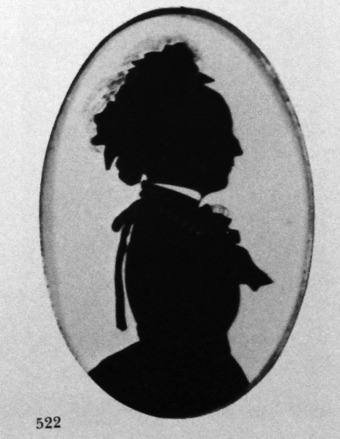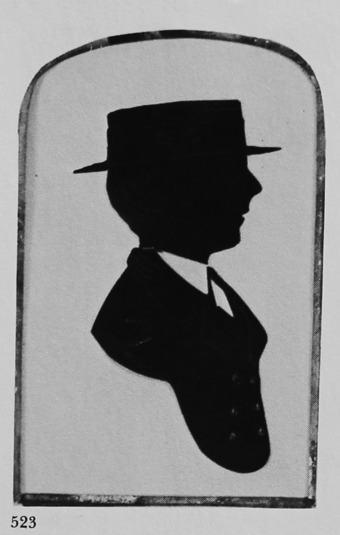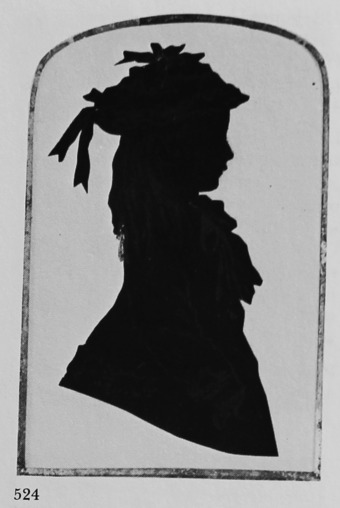Lloyd, George Azariah (McKechnie Section 1)
Probably the same artist as the A. E. Lloyd recorded by Jackson (The History of Silhouettes), although A. E. Lloyd may have been another member of the same family, also working in Brighton. G. A. Lloyd's address in Brighton was in Bedford Street, whereas A. E. Lloyd's was given by Jackson as being on the Chain Pier. Although the known examples of G. A. Lloyd's work appear to date from the 1860s, he may well have started work as a profilist within our period, and I have therefore included him. (Jackson places A. E. Lloyd in the ‘second half of the nineteenth century.’)
I owned a mounted group of silhouettes of six members of one family; to judge from the costume, they were taken during the mid-1860s. I have also seen a dated silhouette by G. A. Lloyd: a portrait of a Mr T. Shaw of Eastbourne (1869).
As G. A. Lloyd refers to himself as ‘Royal Artist’, no doubt he took silhouettes of members of the Royal Family at some time. It is clear from his trade label that he also offered other skills, including the mounting of engravings and the retouching of oil paintings.
Jackson briefly describes A. E. Lloyd's work as cut from black paper and bronzed with gold. All the examples by G. A. Lloyd which I have seen are cut from black shiny paper, with detail roughly added in Chinese white. Men's collars are indicated by gaps in the black paper; heads are cut separately and stuck to the card. One or two examples show rough, brownish brushwork outside the cut paper, indicating hair or decoration on a hat.
The four illustrated examples are from the group of six portraits of one family referred to above. The mother and father are mounted at the side in ovals; the children (two boys and two girls), in the centre, in rectangles with domed tops. Each portrait is stuck onto card, with the artist’s trade label on the reverse.
The main key to the date of the portraits lies in the streamers which hang from the neck of the mother's dress at the back. These were first in the height of fashion in 1866. The father wears a bowler hat (first generally worn in the 1860s, although a hat of this shape had occasionally been seen in the 1820s). The elder son wears a sailor hat; the younger, a boater-style hat, with dangling sash. The older boy wears a ‘Prince of Wales’ pea-jacket; the younger, a belted dress of the tunic type. The mother wears a flat-topped hat well back on her head; the girls wear mushroom-shaped hats, with sashes hanging from the back. The mother wears her hair, in front, flat against the head. The girls wear long hair; the boys, short hair. The sitters are, in fact, wearing typical holiday dress of the late 1860s.
The terminations of the portraits vary as illustrated. Only the profile of the mother has none, continuing to the base of the oval. The group is in a mahogany frame (13 x 18 in.), with gilt surround. Each silhouette has a large mount.
Ills. 521-525

Unknown man
Cut silhouette, one of a family group of six, mounted together
c. 1866
4 x 2 5/8 in./102 x 67mm.
Trade Label
Taken in Brighton.

Unknown woman
Cut silhouette, one of a family group of six, mounted togheter
c. 1866
4 x 2 5/8 in./102 x 67mm.
Trade Label
Taken in Brighton.

Unknown man
Cut silhouette, one of a family group of six, mounted together
c. 1866
3½ x 2¼in./90 x 58mm.
Trade Label
Taken in Brighton.

Unknown woman
Cut silhouette, one of a family group of six, mounted together
c. 1866
3½ x 2¼in./90 x 58mm.
Trade Label
Taken in Brighton.

Trade label of G. A. Llyod.
